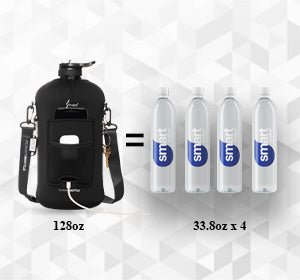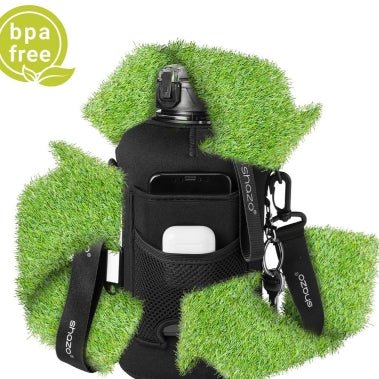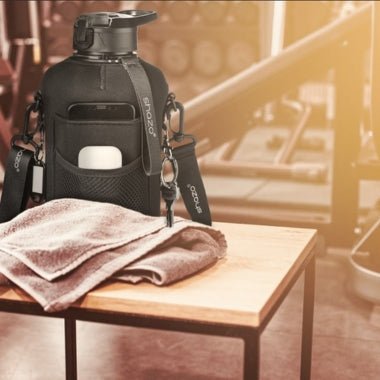How To clean meal prep containers?
Easy ways to clean meal prep containers with lids
Meal prep containers are a convenient and eco-friendly solution for those who prefer planning and preparing their meals in advance. However, to ensure their longevity and hygiene, it is crucial to clean them properly. In this blog, we will explore different tips and methods to keep your meal prep containers spotless and ready for the next round of delicious meals.
Meal prep containers come in various materials, including plastic, glass, and metal, each requiring a specific approach to cleaning. The goal is to safely and perfectly clean containers and remove food residues, stains, and odors without compromising the container's integrity.
Maintaining your meal prep containers instead of frequently buying new ones offers several advantages, both environmentally and economically. Constantly buying new containers contributes to the growing issue of plastic and packaging waste. By maintaining and reusing your meal prep containers, you actively participate in reducing the demand for new production and minimizing waste in landfills.
Different Tips to Clean Meal Prep Containers
Prepping meals is fun and gets really messy while we add our cooking creativity to the meals. But it involves not only making nutritious dishes but also maintaining the tools that make this process worthwhile. To truly savor the benefits of these organizational wonders, it is imperative to probe into the art of proper maintenance, and at the heart of it all lies a fundamental task: washing meal prep containers. It is important to wash meal prep containers so that they remain spotless and ready for the next round of delicious creations. From prompt rinses to utilizing hot water, mild dish soap, and ingenious cleaning methods, we will explore the steps that will elevate your container-cleaning game, contributing to a healthier and more efficient meal prep routine.
1. Prompt Rinse
The first step in maintaining clean meal prep containers is to give them a prompt rinse after use. This quick action helps remove any loose food particles and prevents them from drying onto the container's surface, making the subsequent cleaning process much easier.
2. Use Hot Water
Hot water is your ally in the battle against stubborn residues and oils. When washing your meal prep containers, use hot water to help break down fats and make the cleaning process more effective.
3. Dish Soap
A mild dish soap is essential for cleaning meal prep containers effectively. Apply a small amount to a sponge or cloth and gently scrub the interior and exterior of the container. Opt for a fragrance-free soap to avoid lingering scents affecting the taste of your next meal.
4. Soft Brush or Sponge
For containers with textured surfaces or corners that are hard to reach, a soft brush or sponge comes in handy. Ensure that the brush is gentle enough not to scratch the container while effectively removing any residue.
5. Vinegar for Odor Removal
If your container retains unwanted odors, create a solution of water and white vinegar. Soak the container in this mixture for an hour to neutralize any smells. This natural remedy is particularly useful for plastic containers.
6. Toothbrush for Small Parts
For containers with small and intricate parts, such as lids with tight spaces, a toothbrush can be an excellent tool. It provides precision in cleaning those hard-to-reach areas.
7. Thorough Drying
After washing, ensure that the containers are thoroughly dried before storing them. Leaving any moisture behind can lead to mold growth and unpleasant odors. Consider air-drying or using a clean, dry towel to speed up the process.
8. Regular Inspections
Make it a habit to regularly inspect your meal prep containers for any signs of wear, cracks, or discoloration. If you notice any issues, it may be time to replace the container to maintain both cleanliness and food safety.
INFOGRAPH HERE
I need a simple infograph here with images what suit the heading:
-
Prompt Rinse
-
Use Hot Water
-
Dish Soap
-
Soft Brush or Sponge
-
Vinegar for Odor Removal
-
Toothbrush for Small Parts
-
Thorough Drying
-
Regular Inspections
Let us now read about some general methods to clean meal prep containers; both glass and plastic:
Methods for Cleaning Containers
- Vinegar Bath
Create a vinegar bath by mixing equal parts water and white vinegar. Submerge the containers and let them soak for an hour. This method is effective for both plastic and glass containers.
- Sugar and Ice Cubes
For stubborn stains, a mixture of sugar and ice cubes can act as a gentle abrasive. The combination helps lift stains without causing damage.
- Baking Soda Paste
Create a paste using baking soda and water. Apply it to stained areas, scrub gently, and rinse. Baking soda is a natural deodorizer and cleanser.
- Hand Sanitizer
In situations where water and soap are not readily available, a small amount of hand sanitizer can be used to sanitize the container's surface.
How to clean plastic food containers?
Cleaning plastic food containers and glass food containers requires slightly different approaches due to the distinct properties of each material. Cleaning reusable food containers is a simple process that involves several essential steps to ensure they remain hygienic and safe for reuse. However, cleaning reusable and plastic food containers is relatively easier than glass ones Let us read how can we clean food containers with lids them effectively:
1. Pre-wash:
Before diving into the main cleaning process, give your reusable food containers a quick pre-wash. This involves removing any loose debris, food particles, or leftover sauces. A simple rinse under running water or a gentle wipe with a damp cloth can suffice for this initial step.
2. Wash:
Apply a small amount of mild dish soap to a sponge, cloth, or brush. Thoroughly scrub the interior and exterior surfaces of the container. Pay extra attention to corners, crevices, and any textured areas that may trap residue. Use a soft brush or sponge to avoid scratching the container, especially if it's made of plastic.
3. Rinse:
After washing, rinse the container thoroughly under running water to remove any soap residue. Ensure that all soap has been washed away to prevent any lingering flavors from affecting the taste of future meals.
4. Sanitize:
For an extra layer of cleanliness, especially if the container held raw meat or other potentially harmful substances, consider sanitizing it. You can use a solution of water and a mild bleach (follow the recommended dilution on the bleach bottle) or choose a specialized food-safe sanitizer. Apply the solution to the container and let it sit for a few minutes before rinsing it thoroughly.
5. Dry:
Allow the container to air-dry completely before storing or using it again. Ensuring that the container is completely dry helps prevent the growth of mold and bacteria. If you're in a hurry, use a clean, dry towel to dry the container thoroughly.
Wrapping up
By incorporating these steps into your routine, you will keep your reusable food containers in top condition, ensuring they are ready for your next round of delicious and safe meal preparations. Regularly inspect the containers for any signs of wear or damage, and replace them as needed to maintain both cleanliness and food safety. Maintaining clean meal prep containers is essential for both hygiene and the long-term usage of your containers. Also, it is pocket-friendly because continuously purchasing new containers can be costly over time. By maintaining your existing containers, you save money in the long run. Proper care ensures longevity, eliminating the need for frequent replacements. By incorporating these tips and methods into your routine, you will keep your containers in top-notch condition, ready to assist you in your meal prep journey.



